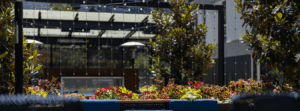Landscape lighting is essential in outdoor design, seamlessly blending functionality with aesthetics. By strategically illuminating various aspects of a landscape, designers can enhance outdoor spaces’ beauty, safety, and usability. Proper and effective landscape lighting design becomes all the more important in places such as Redmond, Kirkland, Seattle, and surrounding areas where outdoor living is valued.
Rich Landscaping Inc., established with over 40 years of expertise, excels at providing tailored lighting solutions that can help enhance outdoor spaces.
The Importance of Landscape Lighting
1. Improving Curb Appeal
A properly lit landscape can greatly enhance a property’s curb appeal. Strategically positioned lights highlight architectural details, illuminate plantings, and create welcoming pathways. In communities such as Kirkland, where homes often have diverse flora, landscape lighting can emphasize the individual qualities of each plant, providing depth and interest to the landscape.
2. Improving Safety and Security
Adequate lighting is crucial for maintaining safety and security outdoors. Walkway and pathway lighting avoid accidents by guiding residents and guests along safe routes. Proper exterior lighting also discourages unwanted intruders, giving residents in Redmond peace of mind. Our team of landscape designers at Rich Landscaping Inc. incorporates security lighting into its designs, pairing safety with good looks.
3. Extending Outdoor Usability
Effective landscape lighting extends the functionality of outdoor areas beyond daylight hours. In Seattle, where evenings can arrive early, illuminated patios, decks, and gardens allow homeowners to enjoy their outdoor spaces well into the night. This extension of usable time enhances the overall living experience and encourages more frequent use of outdoor amenities.
Types of Landscape Lighting Techniques
1. Pathway and Walkway Lighting
Lighting pathways and walkways provide safe passage through the landscape. Low-voltage LED lights are often utilized for this function, offering enough light without being overwhelming. Even Redmond’s most credible landscape designers feel that adding pathway lighting to landscape design can help increase safety and visual appeal.
2. Water Feature Lighting
Illuminating water features like ponds, fountains, and waterfalls enhance their visual impact, especially at night. Strategically using submerged lighting or spotlights can add shimmering effects and transform water features into show-stopping centerpieces in the landscape.
3. Accent and Spotlighting
Accent lighting targets certain elements like sculptures, trees, or architectural features. Spotlighting creates dramatic effects and highlights focal points in the landscape. For example, lighting up a grand oak or a water feature can help bring character and emphasis to your landscape design.
4. Silhouette and Shadow Lighting
This technique involves placing lights behind objects to create silhouettes or in front to cast intriguing shadows. According to the most popular landscape design contractors in Kirkland, silhouette lighting can define the shape of a plant or building against an illuminated background, whereas shadow lighting casts patterns on surfaces, creating texture and depth in the scene.
Choosing the Right Lighting Fixtures
1. LED vs. Halogen Lighting
LED lights are now the go-to option in landscape lighting because they are energy-efficient, long-lasting, and emit less heat. Halogen lights, though preferred for bright light, use more energy and are not as long-lasting. Using LED landscape lights is also in line with sustainable living and saves on maintenance.
2. Solar vs. Hardwired Lighting
Solar lighting presents a green solution, using the sun’s power to illuminate fixtures. Their function may be sporadic in spaces that receive inadequate sun exposure. Hardwired lighting, powered through the home’s electrical infrastructure, is constant in its output but can require more expensive installations. Our landscape designers at Rich Landscaping Inc. evaluate every property’s circumstances to suggest the most appropriate option.
3. Smart Lighting Systems
Integrating smart technology into landscape lighting allows homeowners to control illumination remotely via smartphones or tablets. Features like dimming, color-changing, and scheduling enhance convenience and customization. Implementing smart outdoor lighting systems brings functionality and contemporary style to your traditional landscape lighting design.
Common Mistakes in Landscape Lighting Design
1. Over-lighting
Excessive lighting can lead to glare and diminish the ambiance of outdoor spaces. According to the most popular landscape designers in Seattle, using the right intensity and number of fixtures is essential to achieve a balanced and inviting atmosphere. Professional designers ensure that lighting enhances rather than overwhelms the landscape.
2. Poor Placement
Incorrectly placed lights can cause uneven illumination and overlook intended focal points. Strategic positioning is key to effectively highlight features and provide pathways for safe illumination. Lighting design expertise guarantees optimal fixture location for both form and function.
3. Ignoring Energy Efficiency
Neglecting energy efficiency can lead to higher utility bills and environmental impact. Using energy-efficient fixtures and bulbs, like LED landscape lights, contributes to long-term sustainability and cost savings.
Final Takeaway
Landscape lighting is a revolutionary aspect that adds beauty, safety, and functionality to the outdoors. Professional lighting design has become a necessity in areas such as Redmond, Kirkland, Seattle, and surrounding areas where outdoor living is part of the culture. Rich Landscaping Inc., with years of experience and dedication to excellence, provides customized lighting solutions that encapsulate each client’s individual vision. Our expert landscape designers curate illuminated landscapes that captivate and inspire by integrating innovative techniques and energy-efficient technologies.
Contact our team today at (425) 222-9544 to explore how we can transform your outdoor space with expert lighting design. Experience the perfect blend of aesthetics and functionality tailored to your property’s needs.
FAQs
1. Why is landscape lighting important?
Landscape lighting improves outdoor spaces’ visual attractiveness, safety, and usability. It accentuates architectural and natural elements, offers light for safe passage, and increases the appeal of your outdoor living space.
2. What are the best types of outdoor lights for energy efficiency?
LED landscape lights are the most efficient, using less energy and lasting longer than halogen or incandescent bulbs. Solar-powered lights are another eco-friendly option, and smart outdoor lighting systems with timers or motion sensors help reduce unnecessary energy use.
3. What is the difference between uplighting and downlighting?
Uplighting involves placing lights at ground level to illuminate features from below, creating dramatic effects on trees, sculptures, or architectural elements. Downlighting, on the other hand, involves mounting lights above an area to cast illumination downward, mimicking natural light sources like the moon. Both techniques are used in landscape lighting to enhance depth and ambiance.
4. What is moonlighting in landscape design?
Moonlighting is a specialized downlighting technique where fixtures are placed high in trees or structures, casting soft, diffused light that mimics natural moonlight. This method creates a serene and inviting atmosphere, perfect for patios, gardens, and walkways in landscape design and other urban outdoor settings in Kirkland, Seattle, Redmond, and nearby locations.






